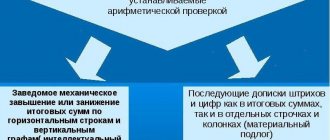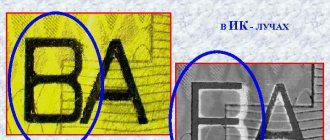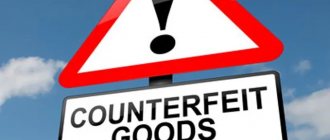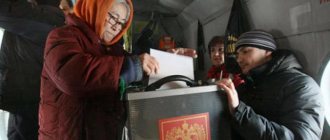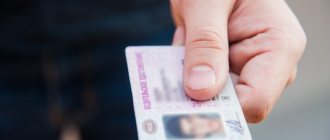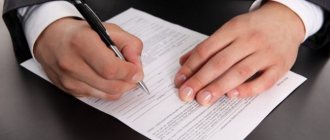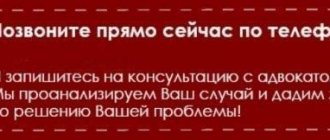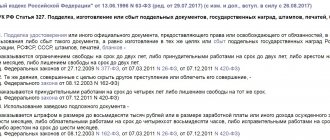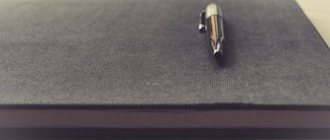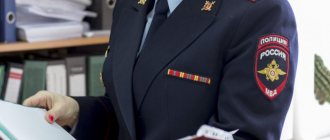Types of document forgery and their signs
During the investigation
- intellectual forgery is detected through investigative, operational-search and judicial actions (interrogation, examination, etc.);
- material forgery - through forensic research, although some of its signs can be identified by the investigator (judge) himself.
Forensic scientists distinguish three types of fakes :
- full;
- partial;
- production of documents of any shape.
Complete forgery - production of all components of a document (paper, form) and details (signatures, seals, stamps, etc.) with a reference to genuine ones. Documents produced on blank sheets of paper (certificates, certificates, certificates) are most often subject to such forgery. Documents produced by printing are less likely to be completely forged.
Currently, various methods are used to protect documents from forgery:
- technological,
- printing,
- chemical, etc.
In this regard, it is almost impossible to completely forge complex documents in makeshift conditions. Consequently, in the process of producing counterfeit documents, they acquire a number of characteristics that distinguish them from genuine ones.
Partial forgery - making any changes to a genuine document by:
- erasures, chemical etching of text, additions, additional printing or corrections of individual letters and words;
- replacing parts of a document (photo cards, sheets);
- forgery of signatures, seals and stamps.
Distinctive signs of partial counterfeit
Erasure, chemical etching of text, addition, reprinting or correction of individual letters, words
Erasing is the mechanical removal of graphic details of documents. Its main distinguishing features:
- ruffled fibers and changes in the gloss of the surface layer of paper;
- reducing its thickness at the point of erasure;
- disruption of the background grid;
- ink smudges of new text applied over erasures;
- remnants of the dye of the strokes of the eliminated text.
Sometimes, for masking, the cleaned area of the document is smoothed with some hard object, and the lines of the background grid are painted on.
Erasures are detected by examining the document in diffuse, oblique, transmitted light, UV and infrared rays, using magnifiers of various magnifications and a microscope.
Restoring the original text is possible by photographing in the rays of invisible zones of the spectrum, in oblique light, with filters, as well as by using the diffuse-copying method.
Etching is the effect of chemical reagents on the graphic details of a document: acids, alkalis and oxidizing agents. In this case, the dye becomes discolored or washed off. The chemical reagent affects not only the text being destroyed, but also the paper, background grid and other components of the document.
Main signs of etching:
- change in the shade of the paper (the appearance of colored spots and borders in places of etching);
- paper roughness;
- disappearance of gloss;
- blurred strokes of new text due to broken paper sizing;
- fragility and brittleness of paper, the appearance of cracks and tears;
- changing the color of the background grid;
- partial discoloration of records as a result of exposure to an etching substance remaining in the thickness of the paper;
- characteristic luminescence of areas with etched text when the document is illuminated with UV rays, etc.
Signs of chemical etching are detected using optical magnifying devices, light filters, oblique lighting, ultraviolet luminescence photography, and also in reflected UV rays.
If dissolution and washing were carried out, then faintly visible strokes of the original text remain in this area, and its general coloring is also observed. Restoration of etched text is carried out by photographing in the ultraviolet and infrared zones of the spectrum.
Addition - adding individual letters, characters, words or parts of text to the graphic details of a document.
Reprinting is the addition of new words, characters or part of typewritten text. As a rule, additional writing and reprinting are small in volume, but can significantly change the data presented in the document. Most often, by adding words, letters, numbers, and sometimes individual strokes, the amount in statements, invoices, receipts, the date of execution of the document, the name of its owner, etc. are changed.
The main features of additions:
- differences in general and specific features of handwriting in the compared parts of the text;
- violation of symmetry;
- presence of unreasonable stops in completed letters;
- possible blurring of strokes made along the folds of the document, differences in color shades and luminescence of strokes in the completed details and the original ones when examined under UV rays.
Main features of reprinting:
- discrepancy in the horizontal position of printed characters in a line;
- differences in the size and design of printed characters of the same name, the color of the ribbon dye;
- the difference in font and mechanism defects if additional printing was done on another typewriter;
- different luminescence of characters in pre-printed and original details when examined under UV rays.
If the text is reprinted on the same machine, they check the coincidence of the lines of the main and reprinted texts, the intensity of the dye in the strokes and some other signs.
Text correction is partial changes in documents by converting some characters into others. In the corrected written characters, there is duplication, thickened strokes, and extra elements remaining from the previous sign. Sometimes these elements are erased, resulting in additional signs of erasure.
Additions, additional printing, and text corrections are detected using optical magnifying devices, light filters, UV and infrared rays, by studying the chemical composition of dyes using spectral analysis, chromatography, etc.
Replacing parts of a document
Replacement of parts of a document is carried out mainly in identity documents. The main signs of replacing sheets or pages in passports, work books, military ID cards and other documents are:
- violation of integrity in places where pages are fastened;
- inconsistency of types and methods of printing in text fragments;
- different size of sheets, mismatch of series and document number;
- violation of page numbering order;
- different luminescence of paper and dye.
Replacement of photographic cards is carried out, as a rule, in passports, identity cards, driver's licenses, etc. Technically, it is carried out in various ways: entirely, with preservation of part of the seal impressions, with removal of the emulsion layer. On the pasted photo card, the missing parts of the mastic or metal seal impressions are affixed by additional drawing or pressure.
Signs that a photograph has been pasted over are:
- peeling of the surface layer of paper at its edges;
- the presence of two different types of glue under the photo card;
- discrepancy in size and design of the letters of the text in the seal impression on the photograph and the document paper;
- inaccurate placement of the photo card in the intended place;
- non-standard size, scale, image details, etc.
Fragments of other similar documents are pasted into some documents (mainly securities, bonds, lottery tickets) to change the series and numbers. Such a fake can be detected under a microscope, in light and in UV rays:
- by mismatches of background grid lines;
- unevenness of paper thickness and fiber looseness;
- traces of glue along the edges of the paste;
- color and shade of paper.
Forgery of signatures, seals and stamps
In addition to graphic copying and sketching, criminals also resort to technical forgery of signatures on documents. With such a forgery, the signature is performed:
- using carbon paper;
- redrawing in the light;
- by squeezing;
- through wet copying and forgery using printers.
The first three methods of forgery are similar to each other, since the forger repeats the movements with which the original signature was made. A counterfeit is detected by visual examination at low magnification under a magnifying glass based on the following characteristics:
- by tortuosity and kinks of individual strokes or parts thereof, underdrawings, blunt ends of strokes, unjustified stops of the writing medium;
- the strokes of black copy paper;
- traces of preliminary pencil preparation when copying a signature against the light;
- depressed strokes not covered with dye, and some other signs.
Forgery of a signature using wet copying is based on the direct transfer of dye from the original signature. To do this, criminals usually use some kind of moistened (sticky) material that is pressed onto a document with a genuine signature, and then this mirror image is copied onto the forged document.
Such a fake is revealed by visually examining the signature under a microscope based on the structure of the strokes: a weak intensity of the dye of the strokes is observed, their edges are indistinct (blurred). In cases where the copied signature is circled additionally, the presence of two dyes can be detected.
Forgery of seals and stamps . A seal is a special cliche used in the preparation of documents for applying imprints that have a specific text depicting the State Emblem of the Russian Federation or a subject of the Russian Federation (stamp seals), an emblem or a symbol (simple seals). A stamp is a special cliche reproduced on documents and business papers to mark the official name of an organization.
Seals and stamps are made of rubber and metal. They are manufactured in compliance with certain requirements. Thus, lines of text are typed in a font of the same size and design, with the same spacing and symmetrical arrangement in relation to the dividing marks, text or design (for example, a coat of arms) in the inner circle. In relation to the center, all letters of the text are located strictly radially. In cases of counterfeiting, deviations from these requirements may occur.
Criminals who fabricate false documents resort to various methods of forging seals and stamps. It could be:
- panache;
- production of cliches on rubber or other materials;
- wet copy from an original print;
- recopying through an intermediate cliché;
- printing using copiers and printers.
Counterfeiting by drawing entails the appearance of such signs as:
- heterogeneity in size and design of letters of the same name;
- piercing the paper in the center of the round seal impression with the leg of a compass;
- non-radial arrangement of individual letters of the text and their asymmetry in relation to the delimiters, text or drawing in the inner frame.
A print forged in this way may also contain spelling and semantic errors.
In addition to the above-mentioned features, prints from handmade clichés are characterized by a mirror image of individual letters and the absence of some elements of printed characters. When wet copying from a genuine print directly onto a document being counterfeited, the main sign of such a counterfeit appears - a mirror image of the print. To avoid this, they resort to intermediate copying onto some sticky material. The print on the document in this case corresponds to the original, but looks pale, microparticles of the intermediate cliche material remain around it, and the luminescence of the paper in UV rays changes.
For prints printed using copiers and printers (laser, inkjet, matrix), it is typical:
- uneven, superficial application of the dye layer in strokes;
- absence of individual elements in signs;
- grain structure of strokes;
- dirty image background;
- change in color of dyes when exposed to organic solvents.
To recognize a qualified counterfeit, one usually has to resort to forensic analysis. Samples of prints for comparative research are obtained on sheets of clean paper before and after cleaning the seal (stamp) with varying degrees of pressure.
The examination can resolve the following issues of technical and forensic examination of documents:
- whether the form of this document is genuine;
- if the form is fake, how was it made;
- whether any accessories and materials seized from the suspect were used to falsify the form;
- whether the document forms submitted for research were made in the same way, using the same devices;
- whether the document was falsified in the manner named in the testimony of a specific person;
- whether the pages in the document being examined have been replaced;
- whether the photo card in a specific document has been replaced;
- are the seals and stamps in this document counterfeit, and if so, what is the method for falsifying them;
- in what way (factory or handicraft) the seal and stamp were made, the impressions of which are in the document;
- whether the imprints on the document are made with a seal and stamp;
- are there any corrections in the document submitted for research;
- whether the signature of a particular person was made by himself or by another entity;
- which of the persons whose handwriting samples are presented is the maker of digital records in the document;
- whether an addition was made in the submitted document by this subject, etc.
0
2.125
What to do if you discover a scam
If you have discovered the fact of document forgery, you must file a complaint with law enforcement agencies. The best option in this case is to contact the police, this is due to the fact that by filing a statement with the prosecutor's office, you will lose more time. This happens due to the fact that the prosecutor's office, after reviewing the document, transfers it to the police.
In the application you must indicate the name of the body you are applying to, the details of its head, the personal information of the author of the application, including a contact telephone number. The circumstances of the discovery of the fake are indicated in detail.
